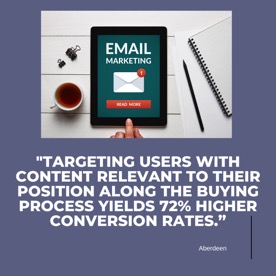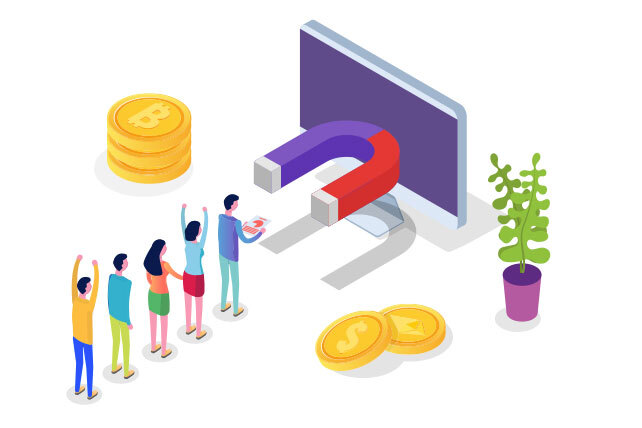One of the best things you can do to build an effective email marketing effort is to carefully consider the quality of subscribers you want on your email list.
In other words, it’s time to get real about qualified leads.
There are big strategic differences in how you choose to develop relationships with subscribers through email. You can choose to send out a newsletter that contains a lot of general information and isn’t effective, or you can choose to move subscribers to become a qualified leads. Salesfusion says, “An astounding 72% of adults in the U.S. still prefer to receive communication from businesses via email.” That means the opportunity to land qualified leads in your email list is incredibly good.
So what is a qualified lead, exactly? It’s a lead where someone is ready to purchase from you — whether that’s right away or in the not-too-distant future. Those who want to make a purchase are in the space of researching and considering possible options and finding businesses able to provide what they’re looking for.
Step 1: Know your audience.
We cannot stress enough the importance of knowing your audience. To do this, you must understand what people on your list are searching for and how your service or product meets that need. This can be tricky because it isn’t simply about knowing the problem you want to help them solve; it’s also about learning where they are in their decision-to-buy process.
By analyzing subscriber data, you can be confident you understand something about all the subscribers on your list. You’ll know that through the different ways they joined your email list to begin with, or what prompted them to interact with you. Did they sign up after attending a webinar? Did they download an ebook you published? Maybe they wanted to read a post on your website. Dig into what spurred them to become a lead for you in the first place.
Based on the type of lead generation that landed subscribers on your list, you should have a better idea of what they’re looking for.
Next, understand that you’re the one driving a subscriber’s buying cycle by creating the process that will qualify that person as a prospect based on the nature of his or her interaction with you.
Step 2: Create quality content.
The KLA Group provides two simple pointers about creating email content that gain qualified leads: Send useful information and provide an educational offer.
Useful information is material that’s going to help your reader; it has value to your reader. You’re going to provide something that adds to what they’ve already received from you, based on how they joined your list. Everything ties back to how they came to be on your list in the first place.
Say subscribers signed up for your email list after reading material on your blog. What additional, helpful information could you provide that would also help you understand more about them by how they interact with it? Perhaps it’s a free download or a different perspective on an issue your audience may care about. Monitor email engagement data to see what you’ve learned about your audience.
When the KLA Group talks about an educational offer, they mean providing something educational for your audience. For instance, a video that contains a how-to explaining something you know they’re struggling with or a case study on how you supported someone to solve a problem. Educate your leads more with quality content they can interact with.
When you think about building content, remember you can always A/B test what you produce to see if different content generates more qualified leads.
Step 3: Understand where your lead is in the buying process.
Profitwell has the following five-step buying cycle that illuminates different phases a potential purchaser of your service may go through.

Ask yourself: Is the person who’s engaging with your content only exploring and not seeking to become involved at a deeper level? Or, is this person looking for information or a product to solve a specific problem? Is the person seriously considering the options available?
Your qualified leads are clear that they have a problem or that they intend to purchase or engage a service. They may be very committed and have a strong intent.
It’s essential to understand where in the cycle your leads are, because at each stage, your messaging needs to be different. You won’t talk to leads in the early stages of investigating a problem in the same way as your leads who know their problem, are looking for help, and are willing to purchase a service or product.

Step 4: Segment, and then talk to each segment as one audience.
Segmentation is a key tool for effectively speaking to your leads. Remember, you’re the one driving the lead’s purchasing cycle. So your goal is to move leads to become qualified leads. And once you’ve segmented your audience, you’ll want to speak to each segment differently.
This means combining what you know about the segment of subscribers and where they are in the buying cycle. When you speak to that segment, you’re more likely to support them moving forward in their decision to purchase.
For instance, if you’re talking to a segment in the ‘awareness’ space, you’re providing broader information about how a problem might manifest or ways to overcome a specific issue. In a way, you’re trying to pinpoint the pain a segment has. When you’re effective, you’ll move that segment into ‘consideration.’
With the segment already in the ‘consideration’ space, you’re talking to them about a product that solves the problem for them. Or you’re guiding them toward information on a specific topic that may lead them to a purchase.
You can see how, by speaking differently to different segments of your audience, you’re qualifying leads more and more.
Step 5: Include one link, and one link only, in your email.
The material you send to a lead needs to be succinct and to the point. It must solve one issue or one problem that person has. One call to action, whether it’s “read more” or “download a free ebook” or “buy now” is all you need to continue moving segments along the buying cycle. Overloading subscribers with lots of links and offers can be counterproductive. It communicates that you’re “throwing everything but the kitchen sink” at them rather than knowing their needs and providing the solution.
Perhaps too often, we treat our email list as simply a list, and we don’t think of each name on that list as someone we can nurture to engage with our business at a deeper level.
Qualified leads are people on a mission to find a solution to a problem. How will you strategically communicate that you’re the one to provide what they’re looking for so they make that purchase from you?
